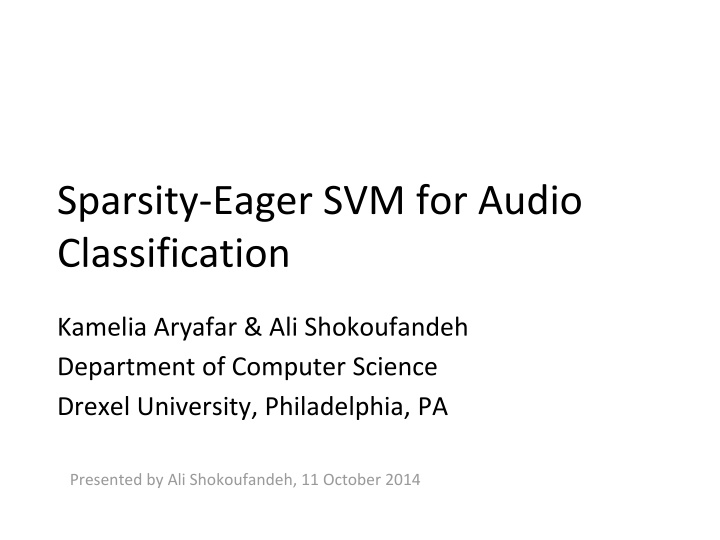
Enhancing Audio Classification with Sparsity-Eager SVM Fusion
Explore how the combination of Sparsity-Eager SVM and regression classifiers can build a robust supervised audio classifier, achieving high generalization on new test examples while avoiding over-fitting. Learn about the integration of SVM principles with sparse regression techniques to create a powerful classification model.
Uploaded on | 1 Views
Download Presentation

Please find below an Image/Link to download the presentation.
The content on the website is provided AS IS for your information and personal use only. It may not be sold, licensed, or shared on other websites without obtaining consent from the author. If you encounter any issues during the download, it is possible that the publisher has removed the file from their server.
You are allowed to download the files provided on this website for personal or commercial use, subject to the condition that they are used lawfully. All files are the property of their respective owners.
The content on the website is provided AS IS for your information and personal use only. It may not be sold, licensed, or shared on other websites without obtaining consent from the author.
E N D
Presentation Transcript
Sparsity-Eager SVM for Audio Classification Kamelia Aryafar & Ali Shokoufandeh Department of Computer Science Drexel University, Philadelphia, PA Presented by Ali Shokoufandeh, 11 October 2014
Connection to Paul Kantor I have known Paul since my graduate school time at Rutgers. As a junior faculty, I was part of an NSF project managed by Paul. Paul was an unofficial mentor during my early Career as Assistant Professor. I also had the honor of collaborating with Paul on numerous research problem.
Goal Build a robust supervised audio classifier by fusing SVM and regression classifiers: Avoid suffers from over-fitting Obtain higher generalization on new test examples. Provide scalability in terms of classification complexity. The subspace model assumption [Donoho 06]: For a sufficiently large number of training instances per class, unseen instance lies on the subspace spanned by training examples. D. L. Donoho. Compressed sensing. IEEE Transactions on Information Theory , 52:1289 1306, 2006.
Support Vector Machine (SVM) SVM is a maximum margin threshold classifier, w(x) = sign(wt.x ), consistent with training examples. If the training data is not linearly separable, soft-margin can be used: Define a Hinge Function: Find w that minimizes the empirical loss (1)
What is known: SVM provides an efficient minimum margin classifier but it suffers from over fitting.
Sparse Regression We are given a matrix X of samples for k classes (r sample per class). We would like to find a classifier for an unknown f: The sparse-approximation classifier will output its prediction as
Fusion: l1-SVM Change the objective function of l2-SVM while avoiding the curse of dimensionality and over- fitting:
Fusion: l1-SVM Change the objective function of l2-SVM while avoiding the curse of dimensionality and over- fitting: K. Aryafar, S. Jafarpour, and A. Shokoufandeh. Automatic musical genre classification using sparsity-eager support vector machines , ICPR 2012.
Fusion: l1-SVM Change the objective function of l2-SVM while avoiding the curse of dimensionality and over- fitting: Classifier:
Experiments: 1886 songs and is comprised of nine music genres: pop, rock, folk-country, alternative, jazz, electronic, blues, rap/hip-hop, and funk soul/R&B:
Experiments: 1886 songs and is comprised of nine music genres: pop, rock, folk-country, alternative, jazz, electronic, blues, rap/hip-hop, and funk soul/R&B:
Experiments: 1886 songs and is comprised of nine music genres: pop, rock, folk-country, alternative, jazz, electronic, blues, rap/hip-hop, and funk soul/R&B:
Experiments: 1886 songs and is comprised of nine music genres: pop, rock, folk-country, alternative, jazz, electronic, blues, rap/hip-hop, and funk soul/R&B:
Generalization The model can be generalized to multi-modal classification: K. Aryafar and A. Shokoufandeh. Multimodal sparsity-eager support vector machines for music classification , ICMLA 2014 13th, 2014.
Generalization The model can be generalized to multi-modal classification:
Final Thoughts Fusing ideas form two distinct class of methods (in this case) made multi-class classification more accurate, and added scalability in terms of classification complexity.
